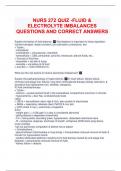NURS 272 QUIZ -FLUID & ELECTROLYTE IMBALANCES QUESTIONS AND CORRECT ANSWERS Explain the basics of fluid balance. ✅*fluid balance is important for temp regulation, nutrient transport, waste excretion, join lubrication, protections, etc! > Types... - intracellular - extracellular = intravascular, interstitial - transcellular = CBS, pericardial, synovial, intraocular, pleural fluids, etc... > Sources of fluid loss - insensible = via skin & lungs - sensible = via kidney & GI tract > avg I&O = 1,500 -3,500/24 hrs What are the risk factors for fluid & electrolyte imbalances? ✅ Explain the pathophysiology of hypervolemia. ✅E) heart failure, kidney failure, cirrhosis (end -stage liver failure), long -term corticosteroid therapy (kidney retention), & excessive fluid replacement (ex: athletes, iatrogenic) P) fluid overload/excess > Types... - isotonic = excess isotonic fluid in the extracellular compartment (common in clinical) - hyponatremia = decr Na+ & diluted body fluids Labs) > CBCs = hemodilution (decr Hgb & Hct), decr protein & electrolytes > ABGs = respiratory alkalosis (decr PaCO2 & incr pH) > CXR (chest X -ray) = pulmonary congestion S/Sx) - weight gain = > 0.5lb gain in a day is considered abnormal - pitting edema in dependent extremities - CV = tachycardia, bounding pulse, hypertension, distended neck/hand veins - R = tachypnea, dyspnea, shortness of breath, orthopnea (SOB when lying down), moist crackles *call out pulmonary congestion & altered neuro status! > Complications... - pleural effusion (fluid buildup in lung lining) = thoracentesis (manual removal of fluid) & monitor for hypovolemic shock - ascites (distended abdomen resulting from fluid backup caused by end -stage liver disease) = paracentesis (manual removal of fluid) - kidney failure = dialysis Tx) - administer diuretics - limit fluid & sodium intake - monitor edema & I&Os - auscultate lung sounds & administer O2 therapy PRN - monitor vitals & HR What causes edema? ✅hypervolemia > incr capillary pressure > capillaries leak fluid into extracellular/interstitial space *edema = pitting in dependent areas, pale/cool to touch, weeping & moist When administering tx, how should the nurse prioritize their actions? ✅1. prioritize physiological needs using the ABCs = Airway > Breathing > Circulation 2. focus on safety & security = prioritize what is the most threatening to the pt's life! 3. address pt's feelings = provide necessary education & emotional support Explain the pathophysiology of hypovolemia. ✅E) severe hemorrhage, iatrogenic (diet restrictions/NPO), excessive vomiting/diarrhea/diaphoresis, diuretic therapy, diabetes, renal disease, NG suctioning, 3rd spacing (intestinal obstruction, peritonitis, ascites, burns) > Risk factors = age (infants & older adults), diuretics, burns & severe infections P) fluid volume deficit from an absolute decr in total body fluid OR from a "relative" movement of fluid from the intravascular compartment to the interstitial compartment > Types... - isotonic = fluid loss from the extracellular compartment Labs) > CBC = hemoconcentration (incr Hgb & Hct) > serum osmolality = measures protein, electrolytes, glucose levels/conc > BUN = measures protein break down > urine specific gravity = measures density of urine S/Sx) - CV = tachycardia, thready pulse, hypotension, syncope (fainting), decr capillary refill, & flattened neck veins - R = tachypnea & hypoxia - Neuro = dizziness, confusion, hyperthermia, weakness, & fatigue - GI = thirst, nausea, vomiting, anorexia, acute weight loss - decr output = oliguria (< 400 mL/day) & anuria (< 50 mL/day) - skin tenting, dry/scaly skin, dry mucous membranes, & furrowed tongue > Complications = hypovolemic shock Tx) *identify cause to determine tx! - health history = age? environment? medications? - weight & I&Os - monitor labs, vitals, & HR = orthostatic hypotension? (change in BP > 20 mm Hg in systolic OR > 10 mm Hg in diastolic within 3 mins of standing) - administer O2 therapy PRN - monitor LOC




